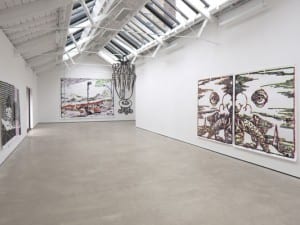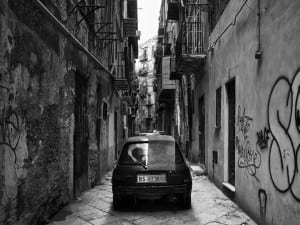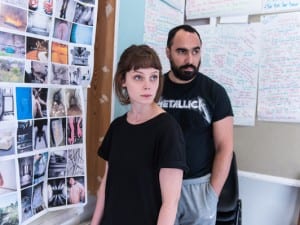In the Special 60th Edition of Aesthetica we celebrate the emerging photographers that are shaping the future of the image-based practice in The Next Generation. We have partnered with the London College of Communication to survey some of photography’s rising stars and showcase their fresh ideas and new concepts. Corinne Silva’s vibrant photographs examine the use of the still and moving image in suggesting metaphysical space. Her visual language engages with the limits of lens-based media and its potential to explore the evolving relationship between politics, landscape and art histories. Silva speaks to us about her Imported Landscapes series and her dual use of photography and film.
A: A shot from your Imported Landscapes series is currently featured in The Next Generation in Aesthetica, can you explain the idea behind this project?
CS: The work explores an ongoing narrative of trade, colonisation and mobility between southern Europe and northern Africa. I made a series of photographs along the coast of northern Morocco, printed them as posters and had them pasted onto billboards in Murcia, south-east Spain. I then made photographs of these site-specific installations. The landscapes in my pictures look and feel the same – the same flora, fauna, climate – and yet they are currently divided by a political boundary. To make the photographs for the billboards I made a journey from Tangier right along to the border with Algeria. This part of Morocco is a former colony of Spain, and parts of it, Ceuta and Melilla, remain so. There has been a history of journeying and occupation across the Straits of Gibraltar since 711 when the Moors crossed the Mediterranean Sea to form a kingdom that reached as far as France. This was a Golden Age, a time of tolerance and growth – scientific, agricultural, and artistic – between the Spanish Muslims, Christians and Jews. The Muslims and Jews were expelled in the 50th century, as part of the Re-conquest. But there has continued to be trade, human occupation and mobility across the straits, including many undocumented people from northern and sub-Saharan Africa who risk their lives to journey into Europe for better opportunities.
A: What did you want to express with this work?
CS: I wanted to allude to the ongoing connections between the landscapes, and by extension, their occupants. Through this site-specific billboard installation, I place one landscape into another, the southern hemisphere into the northern. I set up an intervention in the Spanish landscape. It’s a gentle intervention, the pictures on the billboards are very quiet, they contradict the usual language of billboard advertising, but in some ways what I am doing, or suggesting, is very violent. I think landscape photography can do more than just interpret landscape; it can change it. A photograph is never just a two dimensional image, it’s also a material object and anything placed in the landscape alters it. Here, the dual “image-object” status of the photograph is emphasised by the materiality of the poster, where every crease and join is visible. For me, the most powerful photography isn’t that which aims to give answers, photography can’t do that, but it can open up questions and leave spaces for the imagination to work. So the work aims to create a space between these two places, a third landscape, one in which the viewer might imagine how these landscapes have historically been linked, what the connections are now, and what the implications of these connections are, and then I hope it also creates a space to imagine what might happen in the future.
A: Do you have an ideal location in the world where you would love to take photographs?
CS: It’s less that I have an ideal location and more that I look for places through which to explore certain questions: about how humans attempt to shape and control our environments, and what the consequences of that might be. In recent photographic and video work I’ve been making in London and Palestine/Israel I’ve shifted from looking at architecture to focus more on urban and suburban gardens and the politics of landscaping. I have just embarked on a number of new photographic and video works under the title Rocks & Fortresses, all made around the Mediterranean coastlines. For me, the Mediterranean is a place where I can explore all my questions about political borders, the meeting of the northern and southern hemisphere, and photography’s ongoing role in Empire-building. But its not just about geographical space or architectural space, its about psychic space, so my work is about exploring the unseen as well the visible.
A: You work with still and moving image, how do these two forms compliment one another?
CS: Maybe I can begin by commenting on how I think still photography might sometimes behave like moving image. Imported Landscapes is an example of this. In moving image, the viewer is always aware something is taking place beyond the black lines of the frame. Sound, movement, voices. You are reminded of this by a human figure entering, or the headlights of a car you can’t see, or the sway of a tree branch. You are aware that the tree extends beyond the frame, or that someone is arriving from somewhere you don’t get to access. So your imagination extends beyond the frame. Imported Landscapes works in a similar way, the frames within frames remind the viewer there is always something above and below, behind the photograph that they don’t get to see, but that they can imagine. In this way the viewer becomes an active participant, their imagination has to do some work, they “enter into” the billboard. Of course, there’s another layer of framing added with the photographs of the installation. So there is the first encounter of the site-specific installation, billboards framed by the Spanish landscape. Then when I make the photographs of them, I offer you a further frame, I’m framing Spain now as well as Morocco. I often work with photographic wall installation, and all my still photographic work offers fragments that need piecing together. I never think of the single photograph, but only how a number of photographs relate to one another. This is like the way one reads moving image, but of course, with moving image, the image is constantly being replaced by a new one, you can’t go back. Whereas with photography your eye can roam and rest and return.
A: What elements do you consider when taking a photograph?
CS: Often the actual taking of a photograph comes a long way after a process of research and exploration, testing and feeling my way through a project. Other times the production process is more straightforward. My photographic and sound installation Wounded, which will be shown next year as part of Garden State, a solo show with Ffotogallery, Wales, came out of a discussion with a curator about how a devastating fore in the Carmel forest in northern Palestine-Israel was being portrayed in the national media. I went up there the next day and made a series of nine pictures of this burnt, wounded forest. Then I returned three years later and made the accompanying sound piece – me wrestling my way through waist-height foliage. Since the fire, these indigenous plants have reclaimed the terrain of what was a planted forest. So some projects take years, others a day, but they are always the result of my continual process of reading, discussing, looking and feeling out. That’s why, for me, travelling alone as well as undertaking artist residencies are so important. As well as constantly feeding myself with other visual art, with writing, with film, time to physically explore places and be out of my usual space on residencies allows for insights and connections to be made.
A: What do you have planned for next?
CS: I’m in the final stages of editing a dual-channel video work, Seeker, which looks at urban foxes and urban gardens in London. I use them as an allegory for exploring wildness, cultivation and containment, and visible and invisible walls and boundaries. As I mentioned earlier, I’m making new work in the Mediterranean, beginning in Spain, Palestine and Lebanon. Rocks & Fortresses will be, in part, a collaboration with art historian Martina Caruso who curated a show I was in back in August, My Sister Who Travels. We have had a lot of discussions about Esther Van Deman, whose extensive photographic archive forms the fulcrum of this show. Van Deman was an American archaeologist who lived in Italy, Tunisia and Algeria in the early 20th century. She was a fascinating character, very independent and brave but also isolated, working in a profession that pretty much excluded her gender and in a region where it was extremely uncommon to be travelling as a woman. She was also obsessed with rocks and fortresses, something we have in common. Whereas in previous works, I have alluded to the presence of the photographer, this might be the first time I enter the frame myself.
Corinne Silva is a Research Fellow at the Photography and the Archive Research Centre, (PARC) University of the Arts London. To find out more about her work, visit www.corinnesilva.com.
Credits
1. New suburb of Tangier placed in former mining region La Unión, Murcia from the Imported Landscapes photographic series, 2010.
Follow us on Twitter @AestheticaMag for the latest news in contemporary art and culture.





